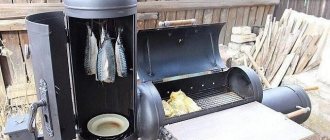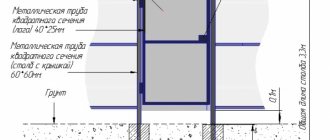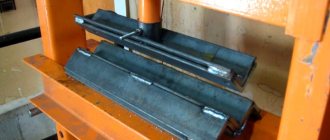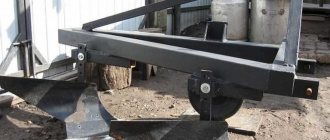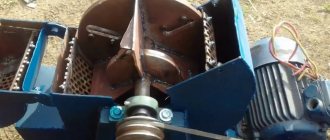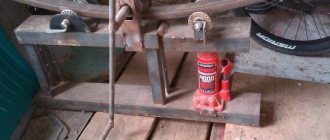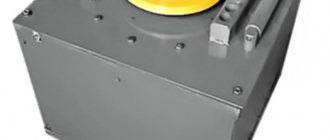In an ordinary smokehouse where wood is burned, the process takes a long time and a supply of fuel. With a smoke generator everything is simpler. The smoke process is based on the slow smoldering of fuel. A fan “or compressor” is connected to the installation, pumping air. From here, the smoke enters the smokehouse, where the products are hung “or placed on shelves.” As you can see, everything is simple. But the result of such a device is worth its assembly. So, by playing with spices and fuel, you can achieve different tastes from the same meat. In addition, as already mentioned, it will last longer than usual.
Fuel for generators
Some purchased models have an electric or gas firebox. However, such smoking can hit the user’s wallet quite hard. But a device that runs on shredded wood saves your savings. Firstly, it does not require electricity; secondly, many owners of private houses, who, as a rule, assemble these generators, have plenty of wood. However, those who do not have it should not be discouraged, since fuel can be bought at the store. Chips or sawdust can be from any tree, except for evergreen ones “such as, for example, pine”: with such fuel you will only spoil the meat, making it bitter.
The size of the chopped wood is also important: for example, for smaller sawdust, you need to add a spring to the design, allowing smoke to pass through unhindered. Larger elements do not require such improvements.
Cooling smoke
The origin of the smoke has been dealt with. But for those who want to use cold smoking technology, this is not enough. This requires lowering the smoke temperature. How to achieve this? There are two ways:
- water. Two tanks are installed inside the generator. Water circulates in one of them, while the other is responsible for cooling the smoke, which simply comes into contact with the cooled walls;
- air. In this case, the smoke is forced by air through a pipe shaped like a coil. This method is chosen most often because it is inexpensive and simple in design.
A few safety rules
Before cleaning the smoke generator, you need to consider the following points:
- the wiring must withstand high temperatures and be located as far as possible from the heating element;
- the surface on which you are going to install the structure must be protected from possible fires;
- when choosing a material, it is better to choose metal painted with heat-resistant paint;
- if possible, provide automatic shutdown so that the unit does not suddenly fail.
Finished smoked product
In general, smoking as a method of food preservation has been known for a very long time. Today it is increasingly relevant and not so much because of the long shelf life, but because of the taste qualities that the product acquires.
Types of homemade generators
The circuits of homemade smoke generators may differ slightly, but they are all united by a common device. They include a chamber in which the pyrolysis process occurs, a heating source, a smoke pipeline and a smoke cooling system. The device can be made using available materials.
You can make a smoke generator from a fire extinguisher, an electric stove, or an aquarium compressor.
Let's look at these and other ideas in more detail.
Electric stove smoke generator
If the idea of homemade smoked sausage has just struck you, and you haven’t prepared for it in advance, you can find a simple and quick way: make it from an electric stove. All other parts can be found in a barn or garage: a barrel without a bottom or a piece of tin pipe, a piece of wire mesh, a sheet of plywood and wood chips.
It is better to set up an impromptu smokehouse outside, then at home it will be difficult to get rid of the aromas that will permeate all things.
- Install the tiles in a place that the extension cord can reach.
- A barrel is placed on the electric stove and wood chips are poured into it.
- At 2/3 of the height, the barrel is pierced with two reinforcing pins crosswise, and a mesh is laid on them.
- This is where your products will be hung.
- The top of the barrel is covered with a sheet of plywood or iron. The smokehouse is ready.
All that remains is to adjust the tile to the minimum temperature so that the wood chips smolder, and from time to time add fresh material for pyrolysis into the barrel.
The smoking process with such a device is not very convenient because you need to constantly monitor the situation, raise the barrel to adjust the temperature, and remove food to add wood chips.
Such a device cannot be called a proper smoke generator for cold smoking, but for temporary use the idea is quite suitable.
Generator for smokehouse from fire extinguisher
A great idea for a homemade smoke generator is to use an old fire extinguisher. You need to cut off the top of it, it will then be used as a lid. You don’t even have to remove the lever; it will become a handle. Below the cut, two holes are drilled in the body for air access and smoke exit.
Thus, you will get a generator with a top ejector. The advantage of using a fire extinguisher is that it is sealed and durable, and is the right size.
This home-made cold-smoked smokehouse with a smoke generator can work continuously for 10-12 hours.
Advice! To prevent the added sawdust from being compressed into a dense mass, a spring is suspended inside the container.
How to use an aquarium compressor for a smoke generator
We have already said that you can use a low-power aquarium compressor to operate a small smoke generator. For this purpose, you will need an active compressor, that is, one that is installed outside the aquarium. Submersible aquarium filters are not suitable for smoke generators.
Such a device can easily serve a small smokehouse with a volume of 15-20 liters.
This will ensure a sufficient supply of smoke. It is better if the device is equipped with air supply power adjustment. It is not difficult to connect a compressor for a smoke generator with your own hands: if it has two air outlets, you need to combine the supply into one channel and insert the hose into the air supply fitting in the ejector.
Such a system can operate around the clock; the pump consumes little electricity.
You can go another way: use a fan for a smoke generator. A computer cooler is suitable for this purpose; it will provide the necessary air injection.
Smoke generator stove for smokehouse
For a large-volume smokehouse, you will need a full-fledged oven. It’s easy to make a smoke generator stove for a cold smokehouse with your own hands: it’s a basic potbelly stove with two levels for fuel: the bottom? for firewood and the top one for wood chips. Pellets, firewood are placed in the lower part, or a portable gas stove is placed, which will heat the upper part with sawdust.
From the top part there is a pipe - a smoke duct, from the bottom - a regular hood, like for a stove.
To lower the smoke temperature, the pipeline is cooled by burying it in the ground or making a water “jacket”. To ensure that smoke enters the smokehouse, the pipe is tilted towards the stove.
Advice! Professionals recommend making the chimney pipe not from galvanized steel, but from stainless or black steel.
Let's look at the main cooking mistakes
- Incorrect salting. To prevent food from spoiling, they must be thoroughly salted. For high-quality salting, take 2-3% salt for every kilogram of meat or fish. It is better to take nitrite salt or a mixture of nitrite and table salt. This way, moisture is better removed from the products.
- Pre-drying. Salted meat contains a lot of moisture, so it should be dried before placing it in the smokehouse. Prolonged drying will result in a dry product. It is enough to keep the meat ventilated for 6-10 hours.
- Using the wrong wood chips. Using wet fuel will result in a bitter taste in smoked meats. The same effect is possible if the smoke generator operates too intensively, so its performance must be monitored.
Considering these simple tips, everyone will be able to prepare stunning masterpieces that will delight even demanding gourmets with their taste, and the cost will be several times cheaper than store-bought dishes.
Homemade smokehouse from a pipe: how to make
A pipe smokehouse is one of the simplest options that you can easily make yourself.
To do this, just follow the instructions and prepare in advance everything you need for work.
Materials and tools that will be required
For a homemade design you need to prepare:
- steel pipe with a diameter of 10 centimeters;
- plastic corrugation - the length should not exceed three meters, or you can use a metal sleeve;
- a piece of metal tube - up to 40 cm with a diameter of 2.5-4 cm;
- a small compressor - an aquarium compressor will do;
- fitting connection, which will have the same diameter as the smoke duct;
- switch and electrical wires;
- thermometer.
The tools you need to prepare are a welding machine and a grinder. It is advisable to have at least minimal experience working with these tools in order to avoid injury during the generator assembly process and do everything correctly and accurately.
Drawing of a smoke generator from a pipe
To make the assembly process easier, it is worth studying the drawings of a pipe smoke generator.
Below is the simplest and most detailed option.
Drawing of a smoke generator made of a pipe with a lower and upper ejector.
Step by step assembly
You need to use all previously prepared materials to assemble a smoke generator, which will be used for cold smoking, with your own hands from a pipe.
- First of all, the camera is made. As a rule, the average height of a smoke generator is 70-80 centimeters. There should be a lid at the top that can be removed. This is necessary so that you can easily pour fuel inside the device. A small container is made at the bottom where the ash will fall.
- In the simplest versions of the generator, wood chips are poured onto the bottom of the device, which is welded tightly to the edge of the pipe. In this case, the structure is turned over to clean it. There is no ash pan in such a homemade smoke generator.
- There is also another design option. The wood chips are poured onto a grate, which is pre-attached at a certain distance from the bottom of the device. The ash that remains after the fuel burns out will fall through the grate. Typically, the bottom of such devices is removable. You can also add a flapper to clean out the ash pan. This option is considered the most labor-intensive.
- Regardless of the chosen option, a small hole is drilled in the lower part of the homemade generator, the diameter of which will be 5-6 millimeters. A minimum amount of air will enter the device through it so that the sawdust slowly smolders.
- If the hole is larger, it may cause a fire.
- In the upper part of the structure, approximately 7-9 centimeters below the upper edge of the pipe used, another hole is made. With its help, the smoke exhaust pipe will be attached to the smoke generator.
- Next the ejector is assembled. This device is used to suck smoke from the smoke generator and direct it into the chimney. A small diameter tube into which pressure will be supplied from the compressor fits a couple of centimeters into the chimney pipe, which has a larger diameter.
Due to the fact that the air moves slowly, a slight vacuum occurs and smoke from the chamber begins to flow into the chimney.
- After all the most important parts have been connected and secured, you only need to finally assemble the homemade smoke generator and check how efficiently it works.
- Chips must be placed inside the structure. It is enough to use 700-800 grams of fuel. It is best to use sawdust from deciduous or fruit trees, which will make the finished smoked product not only tasty, but also quite aromatic.
- Next, you need to tightly close the lid of the device and install the constructed structure in a certain place next to the wall of the smokehouse. If the smoke generator is free-standing, then you need to attach a hose to the chimney, which will be directed directly into the smokehouse.
- Then the fuel is ignited through a small side hole and the compressor is turned on.
- Now all that remains is to ensure that the sawdust smolders evenly and does not die out from time to time, so that you get tasty and aromatic home-made smoked meats.
Important points when assembling yourself
When making and using a smoke generator yourself, it is important to consider a number of factors.
Generator fuel
For high-quality smoke, wood chips or sawdust from fruit trees are suitable: pear, apple, plum, alder, hazel. Cherry and oak chips are also popular.
It is strictly unacceptable to use coniferous and other resinous wood chips. A pungent odor and unpleasant taste can ruin an exquisite delicacy.
It is best to use small wood chips, chopped by hand or using a garden shredder. Sawdust fractions that are too small will smolder unstably and may ignite.
Cooling smoke
When independently designing a device for cooling smoke to a given temperature, it will be necessary to carry out full-scale experiments with pipes of different lengths and a thermometer installed at the outlet. Both too hot and too cold smoke will not allow the full flavor of the smoked product to emerge.
Safety regulations
When using a smoke generator, it is important to follow the following safety rules:
- do not store or place flammable materials, including wood chips or sawdust, within a radius of 5 meters from the device;
- When lighting the firebox, do not use liquid fire starters;
- when opening the smokehouse for visual inspection, the face and hands must be held so that they are not burned by the escaping hot air or steam;
- When working with the smokehouse, use protective gloves and thick clothing.
Where to mount the ejector
Do-it-yourself smoke generators for smokehouses use two ejector placement options: top and bottom.
Bottom placement provides greater productivity, but there is a risk of sawdust burning too quickly. Experienced craftsmen advise letting the sawdust smolder naturally, and placing the ejector in the upper part of the generator, close to the outlet pipe.
Design options
There are many design options for homemade smoke generators. When choosing a specific design, the home master proceeds from the following parameters:
- availability of necessary materials and tools;
- knowledge of processing and assembly technologies;
- device performance;
- Possibility of connecting to an existing smoking chamber.
Do-it-yourself smoke generator for a smokehouse
So, if the manufacture of a spiral-shaped smoke cooler requires proficiency in plumbing and welding at a fairly high level, a less skilled home craftsman can simply replace it with a longer pipe.
Rules for using a smoke generator
Equipment in this category is suitable for cooking fish, various types of meat, mushrooms, and vegetables. The smoking chamber should be regularly cleaned of dirt. Deciduous wood is suitable for backfilling. Spruce, pine and other conifers are not used to prevent clogging with resins.
At the end of processing, fragrant herbs and a couple of juniper branches are added to obtain special aromatic parameters. It is necessary to clarify the features of smoking of different types of initial food products.
When working with a smoke generator for cold smoking, you must follow the general rules of fire and electrical safety. Do not place the combustion chamber near flammable objects. Check the integrity of the wiring.
If the design has a powerful electric heater, it is connected to the network through a circuit breaker according to a grounded circuit.
What is a smokehouse smoke generator: basic definitions and problem statement
Cold smoking technology involves long-term exposure of the original products to the smoke of smoldering wood. This process destroys bacteria and blocks decomposition processes. At the same time, this treatment imparts a specific taste and smell.
The limited temperature range (+16°C to +36°C) allows moisture to be removed slowly.
Using a gentle regimen helps preserve structure, healthy vitamins, and fat. Depending on the size of the pieces and other factors, the process may take several days. The information provided will be useful in creating a list of requirements for suitable equipment:
- It is necessary to create a sufficiently large amount of smoke to ensure rapid smoking.
- To maintain optimal temperature conditions, you need to consider a cooling system.
- The duration of the procedure forces the use of autonomous equipment that performs its functions without careful control.
- To reduce costs, consider creating a cold-smoked smokehouse with a smoke generator with your own hands.
The device of a smoke generator for cold smoking, which you can make yourself
- The figure shows a chamber (1), in which products are placed on hangers for subsequent processing.
- Sawdust (3) is poured into a firebox of a suitable size, made of a sufficiently strong, heat-resistant material.
- The draft adjustment here is organized using a blower (7).
- The compressor (6) supplies fresh air through a flexible hose (5) and pipe (4).
- The container is closed on top with a lid.
- Therefore, the smoke is directed through the connecting tube (2) into the smoking chamber.
Ejector
Experts recommend using the first option. When placing the ejector at the top, you can enjoy the following advantages:
- the volume of the combustion area increases. The likelihood of solid fuel fading is reduced;
- In this option it is easier to ensure slow smoldering. Consequently, you will have to replenish your firewood supply less often;
- The upper location of the ejector with forced air supply creates sufficient thrust. Additional smoke filtration with a backfill layer will be useful;
- lower - contributes to the entry of large particles into the chimney, forcing it to increase its length to reduce the operating temperature in the smoking chamber;
- proximity to a heated area reduces the service life of the pipe and increases the risk of damage to welded joints.
Compressor for smoke generator
This connection of the compressor minimizes the thermal impact on the ejector, which extends the service life of the unit. At the same time, sufficient air flow is ensured to supply smoke to the food processing area.
Smoking chamber
The figure shows an example of a factory smoking chamber. It’s easy to guess that an old refrigerator is quite capable of performing such functions. While maintaining optimal temperature conditions, the components of its structure will not be damaged.
Typical rubber seals will perform their direct functions. Built-in guides and grids are useful for placing food items.
Modernization
The design described above is fully functional. But it has many disadvantages and is not very convenient. Based on the results of its use, modifications and improvements were made.
Adjustable traction
One of the main disadvantages of the described design is poor regulation of combustion intensity. It can be slightly changed by adjusting the compressor performance. An adjustable blower can be added to the design. It can be made according to the gate principle:
- In the lower part of the body (above the place where the stack is attached), weld a piece of round pipe 10-15 cm long.
- Drill two holes that are located exactly opposite one another.
- Take a rod that fits into these holes. Its length is 20 cm greater than the diameter of the pipe.
- Cut a circle from a sheet of metal (2-3 mm thick). Its diameter is slightly smaller than the internal diameter of the pipe.
- Make a “handle” from the rod (bend it).
- Insert a handle into the holes and weld the cut circle.
That's it, the adjustable damper is ready. Turn it, adjust the intensity of air flow, adjusting the intensity of combustion.
Ash pan
Another drawback is that ash spills through the mesh. You can place the smoke generator on a metal plate, but you can make an ash pan. By the way, the gate can be made in an ash pan. This will be more correct, since the air leak can be almost blocked, which cannot be achieved with a damper in the housing - the air enters through the mesh.
The ash pan is made from a piece of pipe with a slightly larger cross-section than the pipe on the body. If you don't have one, you'll have to cook it. The bottom is welded to a piece of pipe, and a thin strip of metal is welded to the body around the perimeter. The body is inserted into the ash pan (the legs are also welded to it).
Condensate collection
When a smoke generator for cold smoking operates, condensation occurs. This makes life difficult, especially if the temperature outside is low. You can solve the problem by making a condensate collector. For this:
- lower the exhaust pipe of the smoke generator downwards,
- at the lowest point we install a container for condensate, welding two pipes to it - one opposite the other;
- on the opposite side the pipe rises again and enters the smoking cabinet.
With this device, a significant part of the condensate ends up in the container. The problem is not so acute.
Design
In order to make a smoke generator for cold smoking with your own hands, you will need the following elements:
- A piece of metal pipe. The pipe can be round or square, with a diameter of approximately 100-140 mm. The pipe will be the basis of the device - the chamber in which the formation and movement of smoke will occur.
- Smaller diameter tubes for making an ejector. The ejector structure is visible in the figures.
- A spring that will be located inside the chamber. It is only needed so that smoke from the lower layers of sawdust can easily rise upward.
- A compressor that will supply air to the ejector.
- Thermometer. Using a thermometer, it will be possible to determine the temperature inside the smoke generator to avoid the possibility of cooling or overheating of the container in which the smoke is generated.
In short, the operating principle of any smoke generator comes down to a simple diagram:
- The smoke generator chamber is heated from below by an external heat source, or the sawdust itself smolders in it.
- Sawdust gives off smoke smoke.
- The smoke rises up and, with the help of an ejector, goes into the chimney, from where it is then directed through a tube into the smoking chamber.
Thus, the smoke generation process is completely automated and does not require any human intervention.
By and large, all these components can be purchased at any hardware or hardware store. To connect the parts of the smoke generator, you will also need construction tools such as an angle grinder and a welding machine, but all this can be borrowed from someone for a while.
Smoke generator stove for cold smoking
If you need to install higher productivity, cook a simple stove. It can be made from the same large-diameter pipe or a rectangular body can be welded from metal. Weld the door and make a chimney fixed at an angle. That's all the difficulties. It is also necessary to divide the internal space into two parts using a horizontally fixed metal sheet.
The lower part is larger, the upper part is smaller. A fire is lit below and sawdust is poured onto the sheet. The rest of the process is known.
A pipe is laid from the stove chimney to the smoking cabinet. It should have an upward slope, albeit a small one. In this case, the entrance to the cabinet should be located in the lower part so that the smoke envelops all the products. Therefore, the cabinet is installed on a platform, legs, or pedestal.
To save space, you can install a smoke generator stove under a cabinet by welding a structure from a metal corner.
But with this design, the smoke can be too hot. Additional measures are needed to cool it. An alternative is to find a larger diameter pipe and put it on the main chimney. Install the cooler so that the air flow is directed into the gap between the pipes.
Another option is to make something like a water jacket, receiving hot water while smoking. But where to put it is the question. Although, warm water is always useful in the household.
A smoke generator for cold smoking of this type requires more costs - metal or a thick-walled pipe, plus a chimney. Moreover, it is better not to make a chimney from galvanized steel - zinc is not a metal that is good for health. Asbestos should not be used either. Firstly, it does not remove heat well, and secondly, it is even more harmful than zinc.
Therefore, the choice in this regard is small - order pipes made of black steel or buy stainless steel. Here everyone decides for himself.
Choosing the right one
In addition to understanding how a smoke generator for cold smoking works, it is important to know what technical characteristics it must meet. Here are some measures of proper quality:
- smoke generator performance;
- intensity;
- maximum automation of the smoke generator;
- simplicity;
- transportability of the smoke generator.
The first point in the characteristics of a smoke generator for smoking indicates how much raw material can be processed in the shortest period of time. The higher the performance of the smoke generator, the larger the smoke supply module and the food chamber should be.
Intensity describes how fast and how much smoke can be delivered. A certain line is important here, because with a large amount of it, it may not have time to cool to 25-30°.
The process must take place around the clock without interruption. This means that wood chips will have to be placed in the smoke generator at night. Not everyone wants to get up specifically for this, so it’s worth thinking about whether it’s possible to implement an automatic feeding system based on a timer or volume.
Installers and designers always try to achieve maximum strength and reliability of the structure while keeping it simple. It is simplicity that allows you to reduce repair and production costs. Also, such products usually last longer. This principle should be based on a smoke generator for a smokehouse. Making the device stationary is a personal decision for everyone. But there is no guarantee that the site where the smoke generator is now located will not be in demand for an economic building tomorrow.
The best smoke generator for cold smoking is considered to be one that is easy to move and install in a new location.
"Labyrinth"
This is perhaps the simplest version of a smoke generator. But it has a number of disadvantages, which will be discussed later.
To make it you will need:
- metal sheet meter by meter;
- the same sheet of perforated metal (the smaller the holes, the better);
- bolts and nuts for installation.
To assemble we do the following:
- cut the perforated metal into strips 20–25 cm high;
- bend the bottom 5 cm strips at an angle of 90°;
- make holes in the bends;
- we form a spiral labyrinth of cuts on a sheet of metal (the clearance between the walls should be 20 - 25 cm);
- we drill holes in the sheet for fastening the walls of the labyrinth;
- We connect the structural elements with bolted fastening.
The “labyrinth” works very simply. A thick layer of wood chips is poured into it and set on fire. Air penetrates through the walls with difficulty, so the wood slowly smolders and does not burn. During this, a large amount of smoke is released.
- The main disadvantage of this design is the need for a smokehouse in the form of a separate room. After all, there are no smoke injection devices here. The smoke generator is placed in one corner of the smokehouse, the products are hung in the other. This avoids excessive heating.
- The second significant drawback is the high consumption of wood chips. To fill a room equipped with a smokehouse with smoke, you need to burn quite a lot of wood.
- Finally, the third disadvantage is low efficiency. The smoke will not be as concentrated as in the other two designs. This means that the smoking procedure will take several times longer.
Therefore, the “labyrinth” is suitable for those who:
- has a separate room for a smokehouse;
- is not afraid of the cost of wood chips (or gets it for free);
- has a lot of free time.
Why do you need a smoke generator?
Cold smoking is a long process, which requires not only equipment, but also a decent supply of firewood and time to maintain. It often lasts from 2 to 7 days, and during this entire period the fire must be constantly maintained in the firebox. it just makes this job easier.
Some factory-made models can work autonomously for days without requiring any attention.
A smoke generator for smoking produces and supplies smoke to the smoking cabinet where the products are located. Pickled meat, poultry or fish come into contact with smoke, after which a whole chain of chemical reactions is activated. Thanks to them, aromatic and very tasty food is obtained.
A smoke generator for a smokehouse is an effective and at the same time structurally simple device. To make it, you can use available materials.
In the cabinet where food is smoked, nothing burns, since the temperature inside is not very high (ranging from +20 to +40 °C). This temperature is precisely a characteristic feature of cold smoking. With the hot method, the smoke temperature is much higher - about 100 degrees.
A smoke generator is a device that produces smoke cooled to room temperature for a long time, often without any supervision from the owner.
Security measures
A smoke generator is a device with increased fire hazard. Despite the low temperature of the smoking process, following these rules will help you avoid trouble:
- The device is installed on a flat, non-flammable surface.
- Painting is possible only with heat-resistant paint.
- The device should be placed away from electrical wiring, flammable liquids and combustible materials.
- The factory device must be equipped with an emergency shutdown system.
Following these steps will not only help you prepare delicious food, but also prevent fires and damage to your health.
Hiking option
- Take an electric stove, turn it on at full power, place a metal container with fruit wood shavings on the stove.
- You will also need a metal barrel.
- The bottom of the barrel is removed (it has no bottom or lid).
- This barrel is placed above the electric stove (the electric stove stands in the place where the bottom of the container was).
- Holes are drilled in the middle of the barrel (4-6 at one level), a grate is lowered into it (the products for smoking are laid out on it), rods are inserted into the holes, they will hold the grate.
- When the tile heats up, the chips begin to smolder and smoke, and the smoking process begins.
- The barrel is not completely covered tightly with a sheet of plywood or something else.
This is a quick fix option. Such smoking will not be beneficial either for a container for wood chips or for an electric stove. But if you use this method not every day, but once or twice a season, then it is quite a worthy country option.
Industrial smoke generator for cold smoking
The figure shows the operating principle of an industrial smoke generator for cold smoking
An industrial smoke generator is more complex than a household one and is designed for continuous operation.
It consists of a wood hopper, a feeding mechanism, a heating element and other parts.
Industrial units allow you to adjust a large number of parameters:
- temperature in the smokehouse;
- humidity;
- smoke density;
- cooking time.
Additional recommendations and conclusion
Having studied the current market offers and after accurately assessing your own strengths, it will not be difficult to make the right decision. To make a smoke generator for cold smoking with your own hands, drawings are not enough. You will need not only theoretical knowledge, but also practical skills. However, with the correct selection of components, in this case the difficulties will be minimal.
A functional smoke generator can be made without extra costs
How it works
A smokehouse with a smoke generator, built with your own hands, is very mobile and compact. When not in use, it can be stored in a garage, basement, or even a closet. This depends on what is used as a smokehouse. You can use any metal box of suitable size for the camera. If there is no ready-made one, then you can make it yourself without any problems.
The box sizes vary, depending on the volume of product you will be smoking.
For home smoking, the optimal dimensions are 1.0 / 0.6 / 0.6 m (H / W / D). The top of the box is closed with a lid with a built-in thermometer and several small (0.3 -0.5 mm) holes to create traction. The upper part of the smokehouse in working condition should be above the smoke generator - this creates additional natural draft, and even when the fan stops, smoke will enter the chamber without delay.
Now you need to assemble everything:
- We install the generator on a fireproof base - a metal table, a concrete slab or floor, ceramic tiles. This must be done for fire safety reasons. In addition to the fact that the smoke generator gets quite hot, pieces of burning wood chips may fall out of it.
- We load approximately 0.5 - 1 liter of dry wood chips, sawdust, shavings of deciduous trees into the smoke generator (coniferous trees are not used for smoking) and close it tightly with a lid.
- We connect the compressor pipe and connect the chimney to the smoking chamber.
- We ignite the fuel through the side hole.
- Turn on the fan.
- The smoking process has begun. The tee with the fan acts as an injector. A vacuum is created in the chimney pipe, which causes smoke to be drawn in from the generator, and a rather noticeable air-smoke flow is directed towards the smoking cabinet. At the same time, an influx of air into the firebox from the outside is formed, through the side openings in the smoke generator. The combustion is self-sustaining and no human intervention is required.
User manual
In order for the unit to use the functions inherent in the design as efficiently as possible, you should adhere to the rules for its operation:
- Before putting the smoke generator into operation, select a surface and install the unit. The surface must be flat and reliably protected from fire, since not only ash, but also unburned coals (so-called heat) often spill into the holes in the generator.
- When placing wood chip fuel in the housing compartment, try to first place thin twigs and chips (10-20 mm) on the bottom, then you can use larger material. You shouldn’t get carried away with creating “wells” or loading branches that are too large.
- When using sawdust as fuel (they will lie denser than wood chips, branches or wood chips, which will slow down or even completely block the exit of smoke), place a steeply curled spring on the pipe that is located at the top (thinner) (you can use a perforated steel pipe ). The quality of the material is not particularly important, the main thing is to choose the right diameter (about 20 mm). The spring can be “tightly” fixed or made removable.
- After this, we place the products prepared for smoking into the smokehouse.
- Close the lid tightly. We connect the compressor with the fitting through the chimney, and the smokehouse with the generator.
- We ignite the fuel and start the compressor.
- Open the ash pan flap.
- When wood smoldering reaches an average level, if necessary, we adjust the air supply with the compressor and the ash damper.
It is absolutely not difficult to make a smoke generator with a damper and an ash pan with your own hands if you have welding skills. This does not require any expensive materials or special tools (except welding). If you want to try cold smoking, be sure to make such a unit, it has excellent traction and allows you to get high-quality smoked products.

